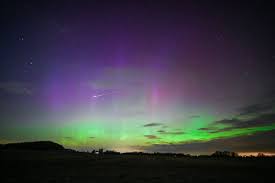A significant geomagnetic storm is set to hit Earth starting on Friday, potentially making the northern lights visible to a much wider swath of Michigan, not just its northern regions. The National Oceanic and Atmospheric Administration (NOAA) has issued a severe geomagnetic storm watch, the first since 2005. This storm is expected to impact Earth’s magnetic field around midday Friday and persist through the weekend.
Geomagnetic storms are caused by disturbances in Earth’s magnetosphere due to energy from solar winds, often triggered by coronal mass ejections from the sun. NOAA has observed at least five “earth directed” coronal mass ejections along with numerous strong solar flares associated with a sizable and magnetically complex sunspot cluster, approximately 16 times the diameter of Earth.
Since the solar cycle began in 2019, there have been only three severe geomagnetic storms. These storms can have widespread disruptive effects on power grids, spacecraft, and radio communications. Space Weather Prediction Center space scientist Robert Steenburg emphasized the potential for induced electrical currents and the importance of alerting operators to mitigate these impacts.
The northern lights, or aurora borealis, typically grace regions closer to the poles. However, during geomagnetic storms, they can be visible in areas closer to the equator depending on the storm’s intensity. This phenomenon is expected to be visible starting late Friday and early Saturday, reaching as far south as Alabama due to the severity of the storm.
Ideal viewing times for the northern lights are after 10 p.m., with many experts suggesting waiting until after midnight. Despite the challenges of forecasting events from 93 million miles away, NOAA’s Shawn Dahl expressed high confidence in the storm’s arrival, though the timing remains less certain.
Michigan’s Upper Peninsula offers excellent viewing opportunities, particularly along the southern coast of Lake Superior, thanks to its high northern latitudes and unobstructed views. While peak viewing times are typically in April, October, and November, the northern lights can be observed year-round, requiring clear skies, darkness, and a bit of luck. NOAA provides a 30-minute forecast to predict the best time for viewing, and there are other apps available for tracking visibility.


















